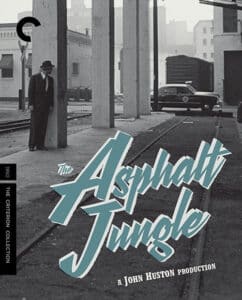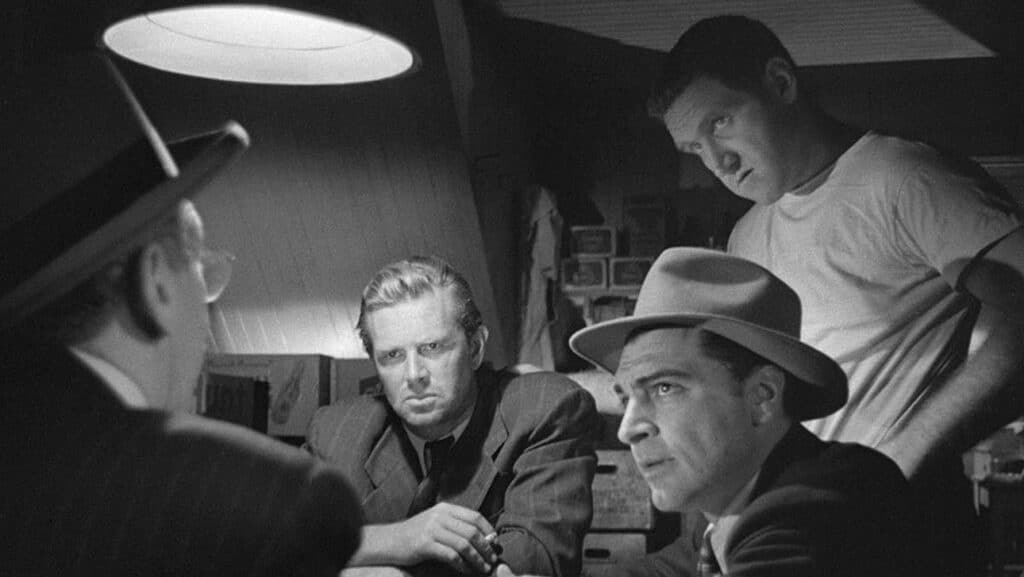
If you can’t do what you want to then you do the things you can.
– The ensemble cast of Stephen Sondheim’s Assassins, in the song “Another National Anthem”.
When it was initially released in 1950, John Huston‘s The Asphalt Jungle had the tagline “The City Under the City!” on its posters. The 2016 Criterion Collection edition of the film describes it as “an uncommonly naturalistic view of a seamy underworld.” The notion that the leading characters in the film are occupying an “underworld” is curious. One can argue that if one is a criminal, he, by extension, participates in the “underworld” of society, where social norms and laws have no import. But the characters of The Asphalt Jungle don’t look like the usual residents of society’s dregs. Dix Handley (Sterling Hayden) looks like any other normal guy. Ace safecracker Louie Ciavelli (Anthony Caruso) is a family man whose criminal identity exists only due to the illegal application of his skill set. In every other way, he’s a father and husband.
The opening sequence of The Asphalt Jungle challenges the notion of a criminal “underworld”. The film opens on what looks like the outskirts of town. (The city is never named, though it’s somewhere in the Midwest.) The landscape is barren, and the sky is murky. Later, Dix walks through rubble-lined alleys. When the Great Depression is mentioned later in the film, one cannot help but wonder if this city ever fully recovered from it.
The eponymous Asphalt Jungle does not need an underworld. We rarely see anyone work throughout the story; Gus (James Whitmore) works at a diner, but the only thing we ever see eat there is a cat. Some people, such as Dix’s tentative flame Doll (Jean Hagen), announce they are looking for work. The Asphalt Jungle has long been lauded for its unsentimental, working-class depiction of its thieves, and it’s precisely the ruined city at the heart of the narrative that produces an environment ripe for criminal activity. Dix, Louie, and Gus get roped into a heist not because they are inherently malevolent; to them, it’s just another “job”. That word is now commonplace in the lexicon of heist films, and its origin derives not from underworld slang but rather from the practical motivations of thieves like Dix. In a city where opportunity is slim, and poverty is a given, one is left to his own devices. It’s called The Asphalt Jungle, after all, not The Asphalt City.
It’s no wonder that Criterion is releasing The Asphalt Jungle, in a characteristically stunning digital restoration, to boot. The Criterion Collection is home to many classics of the noir and heist genre, nearly all of which borrow from Huston’s crime classic. The most obvious inheritor of The Asphalt Jungle‘s legacy is Jean-Pierre Melville, whose films Le Doulos and Le Samourai quote liberally from Huston. Geoffrey O’Brien quotes from Melville in his essay included in the Criterion edition: “Melville once declared that, by his reckoning, there were precisely nineteen possible dramatic variants on the relations between cops and crooks, and that all nineteen were to be found in ‘that masterpiece of John Huston.'”
Those who have stocked up on the Collection’s excellent noir releases would do well to add The Asphalt Jungle to the pile; like other early heist classics, such as Jules Dassin‘s Rififi and Basil Dearden‘s The League of Gentlemen (both available from Criterion), Huston’s inimitable picture helps explain the enduring appeal of the heist flick. Fans of the film should seek out this edition for the high quality of the restoration print, which beats out any other edition on the market.
Dix’s desires are doomed the moment one notices the film traditions from which Huston is drawing inspiration. Film noir is the most obvious of these, and rarely in noir are down-on-their-luck heroes or antiheroes given a happy ending. Muller notes that Huston, a highly literate filmmaker, drew inspiration from the Italian neorealist movement, particularly the films of Roberto Rosellini (Paisà, Rome, Open City). The crumbled cityscapes and economic destitution of The Asphalt Jungle foreground the Rossellini influence, which makes it no surprise that, in the end, the city offers no escape for Dix. In the tragic final moment of the film, a barely alive Dix makes it to his father’s horse farm, only to die just before he can reach the horses. Dix has escaped, but he has no escape.
Film noir historian Eddie Muller, who features in a 20-minute interview with Criterion in the Blu-ray bonus features, notes that Huston does not “condone” the criminal activity in the film. He simply “accepts” it. Dix and his colleagues do not revel in thievery in the way that Gaston and Lily do in Ernst Lubitsch‘s Trouble in Paradise (1932), nor do they stake their identities on being thieves like Danny Ocean and his merry band of 11 do in Steven Soderbergh‘s remake of Ocean’s Eleven. It’s not hard to imagine Dix punching a time card at a local manufacturing plant. He, like Louie and Gus, is a working man; his line of work happens to make him a “hooligan”, an outsider to the city. When Dix is called up by the quirky, recently released convict “Doc” Riedenschneider (Sam Jaffe) to pull off a jewel heist bankrolled by the wealthy Alonzo Emmerich (Louis Calhern), he steps up because he needs work – and, most importantly, a way out of the asphalt jungle.
In a steel-jawed monologue delivered to Doll, Dix announces his desire to return to the horse farm his father owned. Here Dix’s true intentions are revealed: he wants a return to rural, agrarian life, in contrast to the “city dirt” he comes home wearing every day. He’s frequently hampered by his infelicities — especially his love for betting on horses – but his passion is clear. All too familiar with the “pull yourself up by your bootstraps” narrative that permeates American working life, Dix believes he can work his way out of his circumstances through crime or any other means. As many filmic thieves since Dix have said, “A job is a job.” Put another way, crime is, as Emmerich tells his wife, “a left-handed form of human endeavor.”
The criminogenic modern city is the true villain of The Asphalt Jungle. Like Nick Carraway at the end of The Great Gatsby, Dix realizes that there’s no return to the idyllic pastoral in the age of the metropolis. When Dix returns to the horse farm there’s no clear indication, beyond the presence of the horses, that things are what they once were. The dichotomy of the bare rural landscape and the economically bare jungle of cities in The Asphalt Jungle is a pure representation of the divide between the rural and the metropolitan that continues to play out in the United States today. In that way, Huston’s film is both a blueprint for the modern heist movie and a prophetic account of the rise of urbanization.

